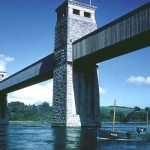
The Britannia Bridge was an engineering masterpiece of the world, opened to the public in 1850. Much has been written about the technical construction but less is known about the people who were involved in the day to day building operation. Who were the men who built it and where did they come from? Did any of your ancestors work on the bridge as stonemasons, brick makers, sailors, contractors, clerks, engineers, foundry workers, riveters or carpenters?
The workforce consisted of:
- The Engineers – The Bridge was the concept of Robert Stephenson, the feasibility of the project was realised by William Fairbairn, and Edwin Clark was the resident engineer.
- The Stonemasons – The masonry contractors, Nowell, Hemingway and Pearson, were from Dewsbury in Yorkshire. Stonemasons and brick makers came with their families to live and work on site.
- The Labourers – Some Irish ‘navvies’ were employed but many of the workforce came from the local area. Unemployed farm workers and copper miners saw an opportunity to earn some money and perhaps develop their skills.
- The Ironworkers – The iron tubes were constructed with skills learnt in the shipbuilding industry and men came from the London shipyards to work on the bridge.
- The Woodworkers – Wooden scaffolding was needed to build the huge towers to a height of over 200 feet. Acres of staging were built for constructing the iron tubes. J&A Greaves were the contractors working with Nowell, Hemingway and Pearson.
- The Sailors – All the materials for building the Bridge were brought on site by sea, with the stone coming from Penmon. Local men, used to sailing the seas around Anglesey, were employed. The weather could be bad and some vessels and loads were lost. When the tubes were eventually floated and lifted into position many more sailors, including men from Liverpool, were hired to take part in the mammoth task.
- The Railwaymen – For the initial testing Robert Stephenson drove the first locomotive across the bridge accompanied by key personnel. Thereafter the C&H railway employees took the powerful engines through the tubes, with a pilot on each train.
- The Public – People turned out in their thousands at the opening ceremony and more than 700 passengers were taken over the bridge on the first crossing. A toast was given to the ladies for their bravery!
We have been researching the workforce of the Britannia Bridge for some years. To collect the names we have searched many sources – newspapers, census returns and church registers. We have also had contact with descendants of the men from across the world. Studies of the stonemasons, the woodworkers and the ironworkers are available to view at Menai Heritage. These give details of the materials used and the jobs involved, as well as the names of some of the 800 men who were employed.
Any questions or information about this project should be directed to:
Julie Stone: juliestone.butterworth00@gmail.com
or through Menai Heritage: info@menaiheritage.org.uk
